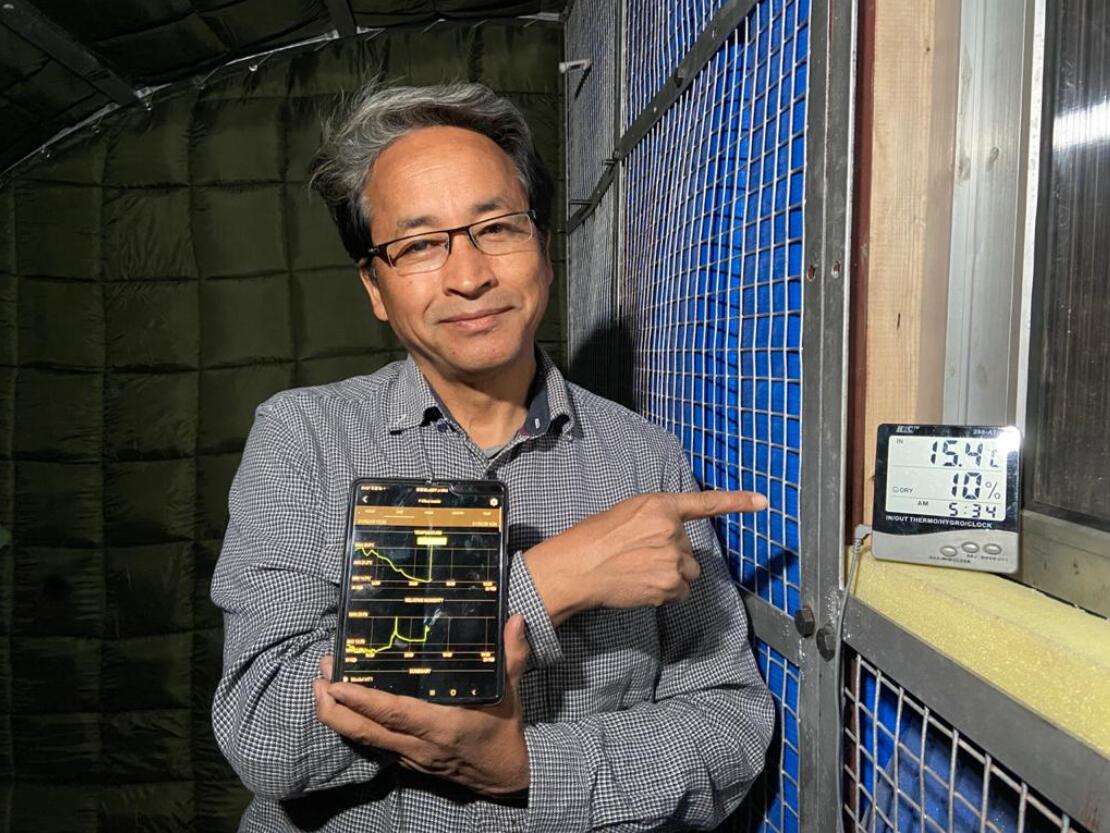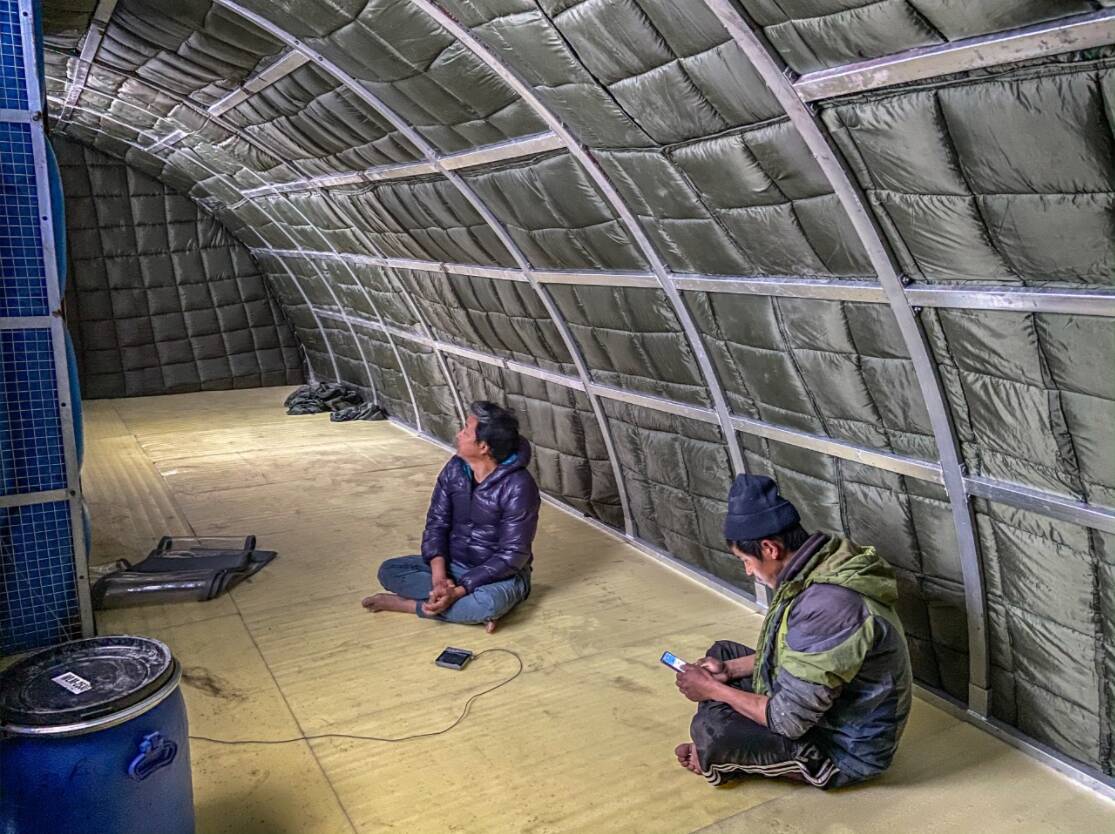Ladakhi engineer, education reformer and innovator, Sonam Wangchuk, is at it once again.
In an announcement made on Twitter last night, Sonam revealed that his team at the Himalayan Institute of Alternatives (HIAL) have developed the prototype of a unique solar-heated tent for Indian Army soldiers stationed in the cold and high-altitude climes of Ladakh.
Exhibiting its insular properties in his tweet, Sonam noted how temperatures inside the tent stood at +15 degrees Celsius at 10 pm on a day when the minimum temperature outside was -14 degrees Celsius. Besides offering more space than the container cabins the Indian Army uses for its soldiers, this structure requires no kerosene for heating purposes and thus emits zero pollution into the environment.
“This is the second prototype of a solar-heated tent I have made. The first one was made about a decade ago for nomads living in the Changthang region, who are constantly on the move but require an upgrade in their living facilities. While people in cities can live comfortably in solar passive houses, these nomads live in smoky old tents with a big gaping hole at the top for the smoke to go out. This leaves them in the cold and in bad health. Unfortunately, the government did not pick up on this innovation and instead continued distributing cotton tents for them, which I thought was a bad idea,” Sonam tells The Better India.
Although this innovation didn’t get picked up, the idea of making a solar-heated tent stayed with him. However, things dramatically changed in the past winter when the Indian Army sent its troops to locations like the Galwan Valley following the recent standoff with the People’s Liberation Army (PLA) of China along the Line of Actual Control (LAC).
“Suddenly, the Army had to station a large number of soldiers in places where suitable accommodation was barely present through the winter, which meant they brought with them things unsuitable for the local environment. Our soldiers, for example, brought large quantities of kerosene which they burnt to keep themselves warm. This is not only a drain on the state exchequer and a massive onslaught against the local environment but also creates serious discomfort for soldiers since kerosene-powered heating is prone to fire accidents. All these reasons made me think about refining the prototype for military use,” he says.

Cost-effective and Balmy Accommodation
This tent is a solar-passive structure that is portable, prefabricated and can be assembled on the spot. Although the globally renowned Ladakhi innovator couldn’t get into the finer details of what materials were used to build this tent since his patent application is being processed, the structure is built on similar scientific principles as solar houses.
“The tent is very insulated from its surroundings with high degrees of solar intake and offers all the space for absorbing the sun. The design is very simple. We use the sun to collect the heat, water to store it and the tent’s insulation properties help retain it in the tent for jawans at night. The tent offers solar intake through the part facing southwards. Insulation comes from all the other sides of the tent,” he says.
Meanwhile, one can dismantle the tent and set it up again anywhere else. Each of the pieces dismantled weighs under 30 kgs, which he argues, can be carried by local porters and jawans and assembled very easily. The conditions are very difficult at high altitudes and the soldiers often carry single-layered tents and piece them together. For soldiers stationed in strategically important and high-altitude locations like the Black Top Hill or the Siachen Glacier, this tent offers comfortable and non-polluting shelter, he claims.
“The number of pieces needed to build this tent depends on the size. You can make it for 10 soldiers, five soldiers or an officer. To build a tent for 10 soldiers, it would require 40 such pieces,” notes Sonam.
It costs about Rs 5 lakh to build this solar-heated tent prototype. In production, he states that it may cost the same or a little less depending on the scale. “What’s important to note is that the container cabins they are using, which offer smaller spaces than our prototype, costs about Rs 9-10 lakh. Our tent will be made at half the cost, offer double the space and deliver the ultimate levels of portability that their current cabins don’t have,” he adds.

But this solar-heated tent that Sonam has developed need not be restricted to simply military use. He notes that these tents can work for anyone who needs ‘quick accommodation’ that is warm, heated and requires no fuel. One obvious market is the tourism sector.
“Any place that attracts tourists but doesn’t have the necessary infrastructure or facilities can use these tents. You can build resorts or camps with these passive solar-heated tents and offer comfortable accommodation for tourists during the annual Chadar trek in winters, for example, where there aren’t any good places to sleep. These tents can also be used for labourers working with the Border Roads Organisation, who otherwise live in pathetic single plastic tents. Instead, they can live comfortably in our tents without contributing to pollution,” he notes.
At the moment, Sonam is in close contact with the Indian Army about his solar-heated tent but production decisions will only be taken after further testing. In about a week or so, they will test the tent at one of the highest motorable roads in the world.
“We will test this tent at Chang-La pass—which is at about 17,600 feet above sea level and on the way to Pangong Lake—for extreme weather and wind conditions. This is as tough as a location for testing purposes,” concludes Sonam.
(Edited by Yoshita Rao)
No comments:
Post a Comment